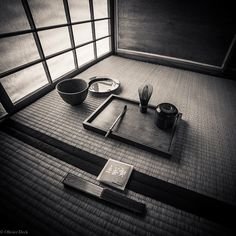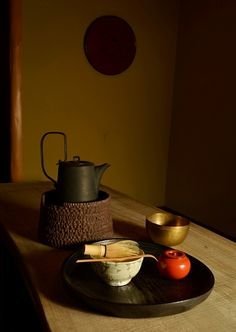Like so many traditional Japanese arts, the formal tea ceremony called chado, or "the Way of Tea," is an ode to harmony—in this case, the harmony between tea, art, nature, organic materials, and people. Highly influenced by Zen Buddhism, chado has been used as a sacred and meditative ritual in Japan throughout the ages. From the processing of the tea to the way it is served, all aspects of the ceremony demand mindfulness and care. While
chado is typically a privileged experience of the elite, you certainly don't need attend a formal ceremony to infuse its spirit into your everyday tea drinking rituals. The powdered green tea present in the ceremony, matcha, can be purchased in specialty stores, and we sell the more common leafed green tea as a primary ingredient in our certified organic line of Fair Trade, blended green teas.

Even before the ceremony, the mindfulness around chado begins with the cultivation and processing of matcha. Brought from China in 1191 by the Zen priest Eisai, it was first valued as a way to keep the devout awake during meditation, then later for its many beneficial properties.Matcha is one of the highest quality green teas, made from the whole, young leaves of the Camellia sinensis plant. Farmers shade the plants to keep leaves thin, delicate and flavorful. After harvest, they steam them, age them, dry them, grind them into a fine powder, and finally store thematcha under air-tight conditions to preserve its intense, bright green color.
Sixteenth century Japanese philosopher Sen no Rikyu perfected much of the ceremony we know today, calling for a return to wabi—simplicity and rustic beauty. During his era of warrior shoguns and samurai, the tea ceremony became a ritual for peace and restraint. Even today, the ceremony continues to teach both guests and hosts the concepts of harmony, respect, purity and serenity. One could easily spend a lifetime mastering this four-hour event. Splendidly choreographed between host and guest, chado calls on participants to live in the moment and focus on the profound beauty around them. Guests may walk across a stone path leading to the teahouse, typically through beautifully landscaped gardens. They then proceed to the teahouse, where their host greets them in a simply adorned room of tatami mats made from woven reeds and either a hanging scroll or a vase of fresh flowers.

Participants kneel on the mats throughout the ceremony, while the host serves guests small dishes of sweets and cups of matcha using deliberate movements as graceful as a Tai Chi master. The host delicately scoops the tea powder into a ceramic cup, pours hot water from a hot iron kettle into the cup with a long-handled ladle, and then mixes the powder and water together with a bamboo whisk to create a thick tea. Every movement calls for total concentration. The host then passes the bowl of tea, allowing everyone to drink from the same vessel in an act of communion. Guests focus their conversation solely on the beauty and craftsmanship of the tea and utensils, all made from organic materials to represent the Five Elements in Taoism—water, earth, wood, fire and metal. Hosts and guests each understand their role in creating the atmosphere.
Living in the fast-paced West, slowing down long enough to appreciate beauty, an uninterrupted conversation or a quiet moment in nature seems almost luxurious. The tea ceremony reminds us to live in the moment, connecting with others and with the earth. Whether you attend a formal Japanese tea ceremony or simply invite some friends to a tea party of your own design, bringing mindfulness into your life and daily rituals can cultivate a spirit of harmony and peace.
Ceremonies requiring mindfulness remind one to contemplate and appreciate the essence of that which created the plant: the spirit within. We in the West consume so many cacao beans and coffee beans without considering that each bean contains within its kernel a lifebforce which is so strong it has the potential to grow into trees of great magnitude and abundance.
The leaf tells a different story.